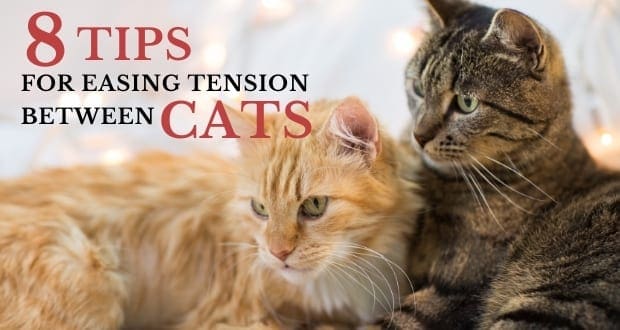
Living in a multicat household has many advantages. Cats learn from each other, play together, form bonds that can become incredibly close, and they fill our hearts with so much love and joy. Living in a multicat household is not without challenges though. Introducing a new cat requires patience and lots of finesse. Some cats take a long time to accept each other and some cats never seem to be able to create peaceful co-existence. There are things you can do to help your cats work out their differences or even prevent squabbles from occurring in the first place.
Note: behavior changes in a cat such as aggression, litter box habits, hiding, change in appetite, etc., can have an underlying medical cause so be sure cats have been checked by the veterinarian before assuming a problem is strictly behavioral.
1. Learn the Social Groups Within Your Multicat Home
Depending upon how many cats live in your home, there could be more than one social group. Take time to really look at who hangs out together most of the time or whether specific cats tend to stay in one area of your home. When altercations happen, are they with the same cats each time? It may be a cat is not happy that another cat who really isn’t part of that social group is trying to access the litter box or get to the feeding station.
2. Create Easy Access to Resources
Two common mistakes I see many cat parents make is they create a single feeding station for their multiple cats, and they also don’t provide the right litter box set-up to ensure safety. When it comes to the feeding station, people may assume that because the cats are willing to eat close together they must be getting along. The problem is, the cats may actually be very stressed about having to eat alongside each other but because that’s the only location for the food, they’re forced to be in close proximity. In this situation you may also see one cat consistently intimidate one or more cats at the food bowl as well. The lower-ranking cats may soon learn to not approach the bowl until the coast is clear. What a cat parent may view as the cats being social may be a situation creating ongoing stress.
The Feeding Station
Don’t assume your cats are getting along because they all come into the kitchen at mealtime. Your cats may not feel comfortable eating out of the same bowl or even eating right next to each other. Create a more peaceful mealtime environment through some separation. If there’s more than one social group in your home, then set up feeding stations so a cat from one group isn’t forced to come into the other group’s territory to eat. Even if you have just two cats, it may be stressful to be side-by-side during dinner. Depending upon the number of cats you have and the level of tension (if any) between them, you may have to set up multiple feeding stations in various locations. For some cats, eating in the same room but just not right next to each other may be enough, but for other cats, they may need to be in separate rooms that are within their own personal territory.
Pay attention to the particular spots where you locate the feeding station as well. Even if you place food and water bowls in multiple locations, put them where they provide maximum security. Give the cats good visual ability when they eat. A cat may want to be able to see if anyone is approaching while munching on the meal. You may find a timid cat prefers being totally hidden while eating or wants to be in an elevated location to ensure maximum visual ability and less chance of being ambushed from behind. There’s no rule that states all food bowls must be on the floor in the kitchen. Place them where they work best for your cats.
The Litter Box
I find some cat parents miss the mark in terms of number and also placement. You should have more litter boxes than you have cats. Usually, one extra box is adequate. Boxes should be placed around the home so cats don’t have to cross another cat’s area when the need to eliminate arises. Don’t make the mistake of having the right number of litter boxes but then placing them all in one room. I see this often when I do in-home consultations and cat parents don’t realize that arrangement may be the very reason one or more of the cats eliminate outside of the box. Pay attention to how the social groups are divided up and where each cat tends to spend the most time. It may not be convenient for you to have litter boxes in different areas of the home but it’ll make a huge difference in your cats’ lives and could very well prevent you from having to clean urine from carpets.
Additional Resources
Resource placement relates to other things as well. Cat trees, scratching posts, perches, and cat beds matter to the cats. If the only cat tree in a multicat home is located in a room controlled by a particular cat, then add another tree or some window perches in other areas. One of the major keys to peaceful co-existence in the cat world is the availability of resources. Don’t put your cats in a position where they must bully, intimidate, defend, or be in fear when it comes to eating, sleeping, scratching on the scratching post, and using the litter box.
3. When Introducing a New Cat, Do it the Right Way
Whether introducing a second cat or adding to an already established multicat family, take the time to do a gradual, positive intro. It’s not about getting the newcomer into the family in record time; it’s about going at a pace that minimizes stress, fear, and worries of threat. Keep in mind the newcomer is coming into totally unfamiliar territory and must get to know unfamiliar people and animals. Nothing smells like the cat, nothing is recognizable, and kitty has to worry about whether the new environment is hostile or not. For the resident cats, there’s an intruder in the home who may threaten their territory. The bottom line with new cat introductions: give the cats a reason to like each other.
Need help with how to introduce the newcomer? You can find step-by-step instructions in my book, Cat vs. Cat.
4. Increase Vertical Territory for Cats
One of the best ways to increase the size of the territories within your multicat home is to think vertically. Add cat trees, cat shelving, cat stairways, or window perches to give each cat more personal space. A multi-perched cat tree becomes a great way for cats to share space at the window while still feeling as if they’re keeping enough distance between them because they aren’t right next to each other. Staggered cat shelving allows cats to pick how high they want to be and if done correctly, allows for easy entry and exit without having to come in contact with another cat. This method also applies to any cat stairways you install; always ensure there’s more than one way up and down so no one ever gets trapped up there by another cat. There should be no dead ends when it comes to elevated territory.
5. Provide Hiding Places for Your Cats
Within your multicat family, there are cats who prefer to be visible and cats who feel more comfortable having the option to hide. This is especially important for timid and fearful cats. By being hidden they can view their environment safely. Hiding places can be in the form of boxes on their sides, donut beds, A-frame beds, cave-style beds, tunnels, open paper bags, and even a cat carrier left open will work.
6. Provide Environmental Enrichment
Cats were born to move and hunt. Provide activities that prevent boredom, distract cats from picking on each other ,and encourage opportunities for fun. When cats don’t have anything to do, that’s when they can start pushing each other’s buttons. One cat may be trying to solicit some social play but another cat may interpret that as a non-friendly approach. Environment enrichment includes everything from interactive playtime, solo playtime, security (such as resource placement), good nutrition and medical care, and interaction with you. A healthy, happy environment allows cats to engage in normal behaviors. Is one cat hiding under the bed all day because there’s a fear of being ambushed? Is another cat sitting in the hallway in front of the litter box to guard it from being used by other cats? Is there a cat in the house who eats too much too fast? Do any of the cats seem bored? Or maybe a couple are engaging in destructive behavior? Hmmm, perhaps it’s time to work on environmental enrichment.
7. Don’t Punish Your Cats
If your cats aren’t getting along, it may be because someone feels threatened, is afraid, or the environment hasn’t been set up to provide adequate resource distribution. Any kind of punishment such as yelling at the cats, squirting with water, spanking, or time-out, will only serve to elevate their dislike of each other. Punishment can also result in a cat becoming afraid of you. An additional side effect of punishment is that the punished cat may lash out and it might get redirected toward another cat. Keep in mind that what you see as “bad” behavior is actually the cat feeling as if there’s no other choice. Instead of punishing, become a cat detective and figure out the cause so you can set the cat up to succeed.
8. Training and Behavior
Use behavior techniques to help lower the volume on multicat tension. As I mentioned earlier, it’s important to figure out the cause of the problem. Once you know the reason, you can set up a behavior plan. That plan will include the above recommendations regarding resources and enrichment, but will also include you actively working with the cats to help them become more comfortable. In more severe cases you may have to separate cats completely and do a total reintroduction as if they’ve never met before. Clicker training may also be a big help in creating a training “roadmap” so the cats learn what behaviors are rewarding and which ones aren’t.
If you end up scratching your head in total confusion as you try to figure out how to help your cats get along, talk to your veterinarian about a referral to a certified cat behavior expert.
Need More Information?
For more information on cat behavior and training, refer to the best-selling books by Pam Johnson-Bennett, including the revised and updated edition of Cat vs. Cat, her guide to managing multicat households. Pam’s books are available at bookstores and online. We’ve included Amazon links here on our website.
If you have a question about your cat’s behavior or health, contact your veterinarian. This article is not intended as a medical diagnosis nor is it a replacement for your cat’s regular veterinary care. This article is for general information purposes only.



